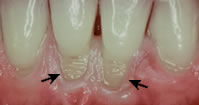When the enamel of a tooth is worn away, the tooth often becomes sensitive and is more susceptible to decay. Advanced cases often require crowns to save the teeth.
Tooth enamel may be worn away in several ways. One or more of the following factors may cause premature wear:
Attrition
 Attrition
is the gradual loss of enamel through "wear".
A small amount of attrition may be caused by normal
speaking and eating, but this typically doesn't produce
excessive wear. More extreme cases of attrition are
typically caused by Bruxism,
the grinding of teeth against teeth. Bruxism
typically occurs at night while the patient sleeps,
so often the patient is unaware of the grinding or enamel
loss.
Attrition
is the gradual loss of enamel through "wear".
A small amount of attrition may be caused by normal
speaking and eating, but this typically doesn't produce
excessive wear. More extreme cases of attrition are
typically caused by Bruxism,
the grinding of teeth against teeth. Bruxism
typically occurs at night while the patient sleeps,
so often the patient is unaware of the grinding or enamel
loss.
Abrasion
 Abrasion
is the wearing away of tooth enamel by a foreign object.
Common causes of abrasion are:
Abrasion
is the wearing away of tooth enamel by a foreign object.
Common causes of abrasion are:
- Brushing too hard or too long
- Fingernail biting, chewing on pens or pencils, holding needles or pins between the teeth, etc.
- Oral jewelry - Patients with pierced lips and/or tongue often wear away the enamel on adjacent teeth
Erosion
 Erosion
is the chemical wear of tooth enamel. Typically this
kind of wear is caused by an acid. Citric acid is one
of the most common agents. Citrus fruit (lemons, limes,
oranges, grapefruit) contain citric acid, as do most
soft drinks and citrus juices (like lemonade). Some
candies also contain citric acid. Many soft drinks contain
additional harmful acids. Coffee and tea also contain
corrosive acids. Bulimic individuals (people who intentionally
and repeatedly induce vomiting) also expose their teeth
to very strong stomach acids.
Erosion
is the chemical wear of tooth enamel. Typically this
kind of wear is caused by an acid. Citric acid is one
of the most common agents. Citrus fruit (lemons, limes,
oranges, grapefruit) contain citric acid, as do most
soft drinks and citrus juices (like lemonade). Some
candies also contain citric acid. Many soft drinks contain
additional harmful acids. Coffee and tea also contain
corrosive acids. Bulimic individuals (people who intentionally
and repeatedly induce vomiting) also expose their teeth
to very strong stomach acids.
Occasional exposure to most dietary acids is rarely a problem, but repeated exposure to high levels of these acids can cause premature wear. Some common habits to avoid are:
- Regularly sucking on lemons or limes
- Regularly eating or sucking on candies, especially "sour" candies as they often contain sugar and citric acid!
- Drinking several soft drinks daily, even "diet" soft drinks
- Drinking several glasses of lemonade daily
- Drinking several cups of coffee or glasses of tea daily
Even if you only occasionally eat or drink highly acidic foods, it's a good idea to at least rinse your mouth with fresh water when you are finished in order to reduce the amount of time the acids have to work on your teeth.
If you would like us to examine your teeth to determine whether or not there is premature wear of enamel, please contact us for an evaluation. It is possible that a mouth guard can be fabricated to control or prevent the enamel loss.







